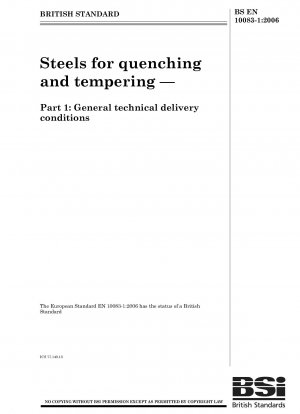BS EN 10083-1:2006
Steels for quenching and tempering - General technical delivery conditions
- Standard No.
- BS EN 10083-1:2006
- Release Date
- 2006
- Published By
- British Standards Institution (BSI)
- Status
- 2018-06
- Replace By
- BS EN ISO 683-1:2018
- BS EN ISO 683-2:2018
- Latest
- BS EN ISO 683-1:2018
- BS EN ISO 683-2:2018
- Replace
- 05/30132585 DC-2005 BS EN 10083-1:1991
- Scope
- This part of EN 10083 specifies the general technical delivery requirements for - semi-finished products, hot formed, e.g. blooms, billets, slabs (see NOTES 2 and 3), - bars (see NOTE 2), - rod, - wide flats, - hot-rolled strip and sheet/plate, - forgings (see NOTE 2) manufactured from the direct hardening non alloy steels for quenching and tempering (see EN 10083-2), the direct hardening alloy steels for quenching and tempering (see EN 10083-3), the non alloy flame and induction hardening steels (see EN 10083-2) and the alloy flame and induction hardening steels (see EN 10083-3), and supplied in one of the heat treatment conditions given for the different types of products in the relevant tables of EN 10083-2 and EN 10083-3 and in one of the surface conditions given in the relevant tables of EN 10083- 2 and EN 10083-3. The steels are generally intended for the manufacture of quenched and tempered, flame or induction hardened machine parts, but can also be used in the normalized condition (see EN 10083-2). Where applicable, the requirements for mechanical properties given in EN 10083-2 and EN 10083-3 are restricted to the relevant tables in these documents. NOTE 1 European Standards on similar grades are listed in Annex C. NOTE 2 Hammer forged semi-finished products (blooms, billets, slabs etc.), seamless rolled rings and hammer forged bars are in the following covered under semi-finished products or bars and not under the term "forgings". NOTE 3 Special agreements should be made when ordering un-worked continuously cast semi-finished products. NOTE 4 In accordance with EN 10020, the steels covered by EN 10083-2:2006 are quality and special steels, the steels covered by EN 10083-3:2006 are special steels. The differences between quality and special steels are characterized by the following requirements, which are valid for special steels only: - the minimum impact values in the quenched and tempered condition (for non alloy special steels in the case of mean percentages by mass of carbon < 0,50 % only); - limiting hardenability values in the Jominy test (for non alloy steels in the case of percentages by mass of carbon > 0,30 % only); - limited oxide inclusion content; - lower maximum contents for phosphorus and sulphur. NOTE 5 This European Standard does not apply for bright steel products. For bright steel products EN 10277-1 and EN 10277-5 apply. In special cases, variations in these technical delivery requirements or additions to them may be agreed at the time of enquiry and order (see Annex B). In addition to the specifications of this European Standard, the general technical delivery conditions given in EN 10021 are applicable unless otherwise specified.
BS EN 10083-1:2006 Referenced Document
- EN 10002-1 Metallic Materials - Tensile Testing - Part 1: Method of Test at Ambient Temperature
- EN 10020:2000 Definition and classification of grades of steel
- EN 10021 General technical delivery conditions for steel products*, 2024-04-18 Update
- EN 10027-1 Designation Systems for Steels - Part 1: Steel Names
- EN 10027-2 Designation systems for steels - Part 2: Numerical system*, 2015-04-01 Update
BS EN 10083-1:2006 history
- 2018 BS EN ISO 683-1:2018 Heat-treatable steels, alloy steels and free-cutting steels. Non-alloy steels for quenching and tempering
- 2006 BS EN 10083-1:2006 Steels for quenching and tempering - General technical delivery conditions
- 1991 BS EN 10083-1:1991 Quenched and tempered steels - Technical delivery conditions for special steels
